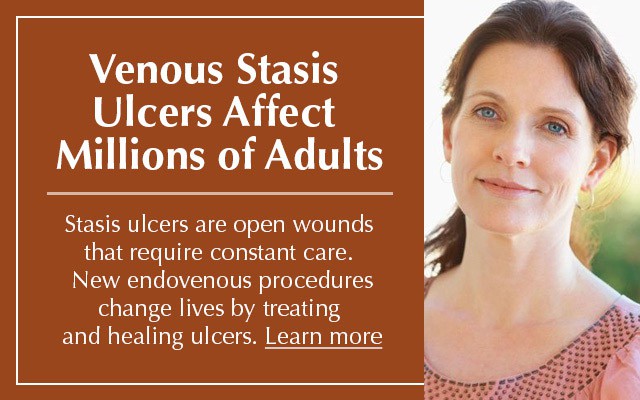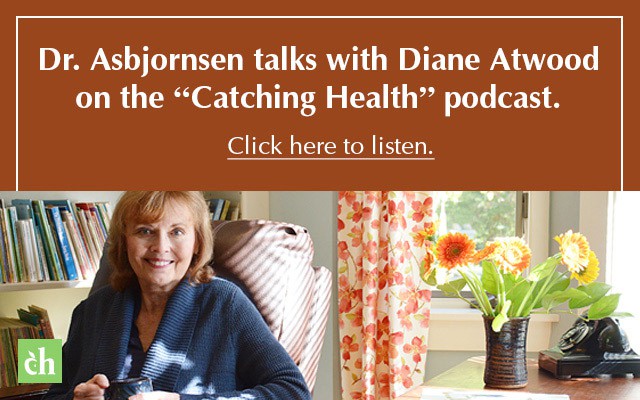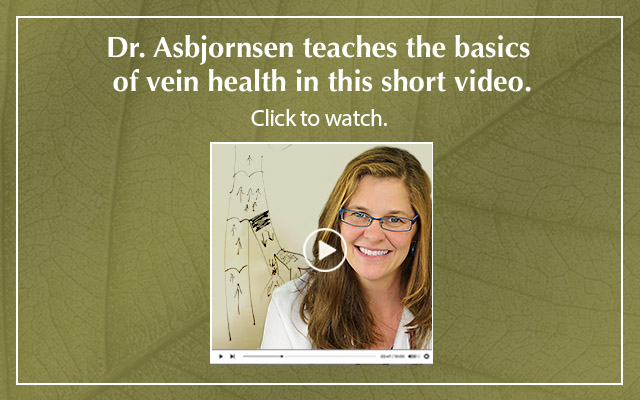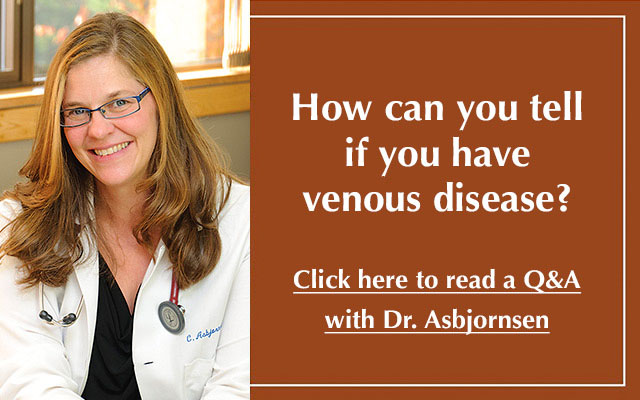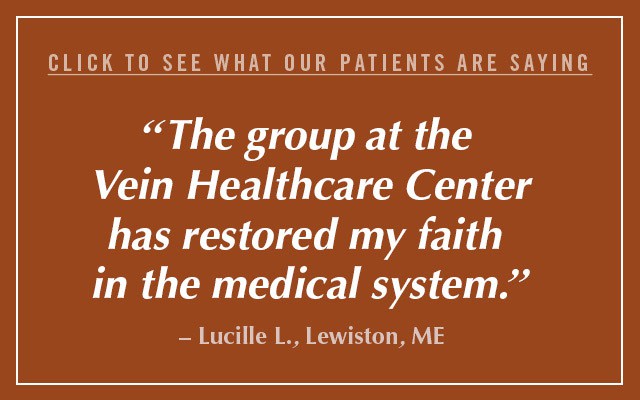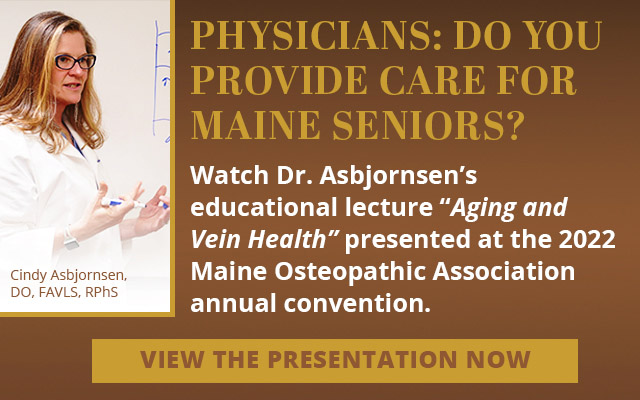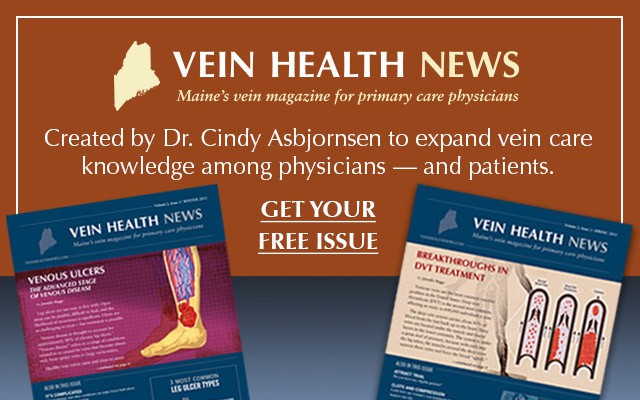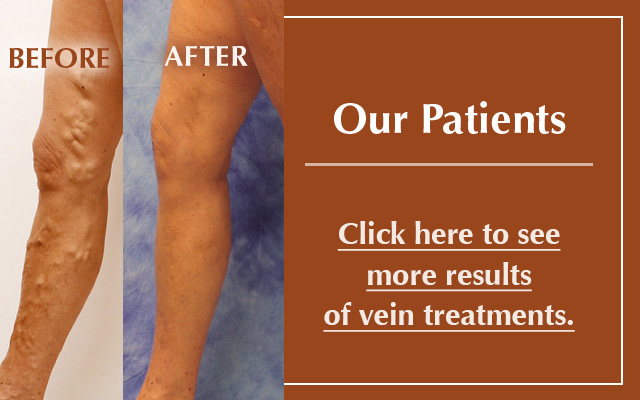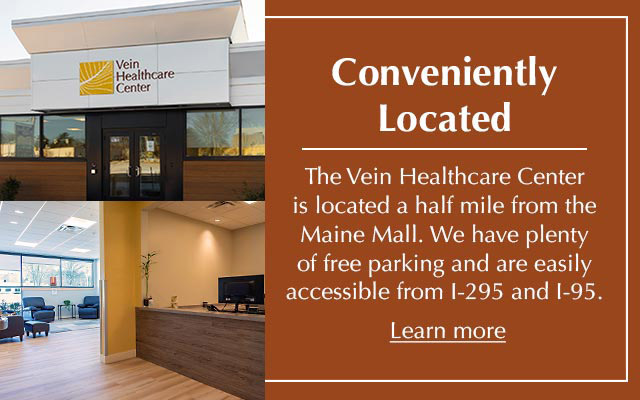Venous Disease Treatment Options
Today's Treatments are Reaching New People
The treatment of venous disease today is vastly different from treatments performed in the past. Breakthroughs in minimally invasive treatment and the many effective out-patient procedures available are providing more people relief from their venous disease symptoms.
These new approaches to treatment involve less time and less pain, and they are overwhelmingly successful over the long term when performed by an experienced phlebologist. People no longer have to live with pain, discomfort, or embarrassment. By treating the symptoms, you will stop the progression of disease and improve your quality of life.
Comprehensive Care from a Trained Phlebologist
It is critical that venous disorders be treated appropriately by a vein specialist (also called a phlebologist). The source of the problem and how one’s overall health is affected must be considered a part of patient care.
During an initial visit to the Vein Healthcare Center, your legs will be visually assessed and an ultrasound may be ordered in which a trained vein specialist uses "ultrasound mapping" to diagnose the patient. Ultrasound mapping uses high-frequency sound waves to create images that form a map of the venous system. This map is used to determine the individual's pattern of diseased veins and to identify the source of insufficiency so effective treatment can begin.
Treatment Options
Endovenous Treatments
Endovenous Treatments can be divided into two categories:
- Thermal treatments that use laser energy or radio frequency waves to treat the vein and tumescent anesthesia to protect tissues surrounding the vein during the procedure.
- Non-thermal, non-tumescent (NTNT) treatments, which are procedures that do not require the use of heat or tumescent anesthesia.
Thermal endovenous treatments include endovenous laser ablation (EVLA), also called endovenous laser therapy (EVLT™) and radio frequency ablation (RFA). These are minimally invasive treatments used to address specific large varicose veins in the legs. It is considered the gold standard in treatment of named veins, such as the great and small saphenous veins. It has largely replaced previous, more invasive standards of care, such as vein stripping.
Endothermal ablation has opened the door for many patients with venous disorders to eliminate symptoms and improve their appearance with minimal time investment and minimal pain. Endothermal ablation is an outpatient procedure performed with local anesthetic.
Endothermal ablation
The procedure begins with the placement of an access port placed directly into the problematic vein. Prior to the placement, the skin is numbed with a small amount of local anesthetic. Once access is established, a laser fiber is threaded into the vein up to the place where health meets disease. This can't be felt because the inner walls of the veins do not have sensor receptors. Once in position, more numbing medicine is added to the outside of the vein; it should not be more uncomfortable than the first pinch when access was established.
Once the leg is numb, the heat source is turned on or "fired," sealing the vein shut from the inside out. The vein eventually is reabsorbed by the body and will no longer be visible on the surface of the leg. Blood is diverted to the many other healthy veins in the leg, and there is no ill effect from the loss of the troublesome vein. Patients are able to return to work the next day with very limited restrictions.
What is Tumescent Anesthesia?
The thermal endovenous treatments involve tumescent anesthesia, a technique in which a high volume of a dilute local anesthetic is infiltrated around the vein. Tumescent anesthesia serves three purposes during thermal ablation:
- The fluid is an anesthetic, keeping the patient comfortable during the procedure.
- It creates an insulating ring around the vein and thermal energy source. This protects all surrounding tissues, including nerves and muscles, thus stopping any type of collateral damage.
- It causes the vein walls to collapse around the thermal fiber, maximizing contact and increasing the effectiveness of the procedure.
The tumescent fluid can be administered in many ways, but at the hand of a trained and proficient physician, the process is comfortable and painless.
Non-thermal, non-tumescent (NTNT) Treatments
Non-thermal, non-tumescent (NTNT) modalities are newer procedures that do not require the use of tumescent anesthesia. Current NTNT techniques include: chemical ablation (Varithena), mechanico-chemical ablation (ClariVein), and cyanocryalate adhesives (VenaSeal).
Varithena
Varithena is a form of sclerotherapy, in which a medicine is injected into the vein causing it to collapse and seal itself shut. The body will then reabsorb the vein into local tissue, in effect making the problematic vein disappear, shunting the blood into the healthy collateral veins.
Foam sclerotherapy has been used widely in the Phlebology community in the past dozen years. The "Tessari method," the practice of adding a gas to a liquid to create bubbles, has been the most common technique for producing foam for use in sclerotherapy. This technique involves manually mixing a small volume of liquid sclerosant with a volume of room air or other gas using two syringes and a three-way tap, or stopcock. Preparations created this way are referred to as "physician-compounded foam," and they are illegal.
While physician-compounded, non-proprietary foam is inexpensive to make, medical experts caution that there are risks: there have been a number of published cases of micro-air emboli (small bubbles of gas in the bloodstream) from so-called "homemade foam" leading to neurological events in patients, including migraines, vision changes, strokes, and death. No physician-compounded foam has been approved by the U.S. Food and Drug Administration.
Varithena is a proprietary foam preparation that was approved by the FDA in 2013 after rigorous safety tresting on thousands of people. It is a chemical foam solution indicated to close the Great Saphenous Vein (GSV) and related tributaries. It is a proprietary mixture of 1% polidocanol, 65% oxygen, 35% carbon dioxide, and less than .8% of nitrogen.
When a physician creates his own foam, he uses room air, which can contain as much as 78% nitrogen. While oxygen and carbon dioxide are rapidly absorbed into the blood stream, nitrogen is very slowly absorbed and those bubbles can persist and possibly cause a gas embolism and obstruct an important blood vessel. Varithena, in comparison, has extremely low nitrogen
Varithena's primary safety feature is the consistency of its bubbles: each one is between 100-500 microns, with uniform density and stability— a standardized compound that is much more predictable for vein doctors to use on their patients, compared with physician-compounded foam, which isn't subject to any manufacturing standards. There have been no strokes or air embolisms associated with Varithena treatment.
ClariVein
The ClariVein Infusion Catheter (ClariVein-IC) is a system designed to introduce sodium tetradecal (STS) agents into the dysfunctional vein. The ClariVein device was cleared by the FDA in 2008.
ClariVein-IC is designed with a 360˚rotatable fluid dispersion wire connected to a proximally located integral battery powered motor drive unit. The catheter is introduced through a micro-introducer at a single location, where the catheter sheath is navigated through the vein to the treatment site using ultrasound imaging. STS is then delivered through its infusion port, surrounds the dispersion wire, and exits via an opening at the distal end of the catheter.
The delivery of the fluid is enhanced by the use of the rotating dispersion wire to mix and disperse the infused fluid in the blood stream and on the vessel wall. In other words, the rotating inner wire agitates the inner lining of the vein, and when the fluid is sprayed from the top of tip of the catheter as it is pulled back, coverage is through and the effectiveness of the fluid is increased.
Because there is no heat, tumescent anesthesia is not required. Because less tissue around the vein is disrupted, this modality causes less inflammation and produces less swelling and bruising after the procedure.
Although ClariVein is still a relatively new device in the vein care specialty, several pivotal clinical studies using the ClariVein-IC system have been published, with data that were comparable with the results using EVLA methods.
VenaSeal
Cyanoacrylate, a kind of strong, fast-acting medical adhesive, that has been used in the treatment of blood vessel abnormalities for more than a decade. In February 2015, the FDA approved the VenaSeal Closure System, which uses a medical adhesive to permanently treat varicose veins in the legs.
The VenaSeal system is made up of an adhesive, a specially formulated n-butyl-2-cyanoacrylate, and delivery system components that include a catheter, guidewire, dispenser gun, dispenser tips, and syringes.
During the procedure, the physician fills a syringe with the medical adhesive, and then inserts it into a dispensing gun attached to an application catheter. Using ultrasound imaging, the doctor inserts the catheter through the skin into the diseased vein to allow injection of the VenaSeal agent, a clear liquid that polymerizes into solid material.
The catheter is placed in specific areas along the diseased vein and the physician conducts a series of trigger pulls to deliver the medical adhesive, thus sealing the incompetent venous valve and eliminating reflux. Compression is applied to the leg during the procedure, according to the indication for use by the FDA, but since it is not required post-procedure, VenaSeal is an attractive option for patients who cannot tolerate compression stockings.
VenaSeal closures are performed in a minimally invasive outpatient procedure and produces minimal-to-no pain or bruising.
Sclerotherapy
Sclerotherapy is an injection of a medicine directly into the problematic vein. In this procedure, small needles provide access to the vein so a medicine called a sclerosing agent can be injected into the vein's interior wall. This substance causes the vein to become sticky and seal shut. Blood then finds a healthy path back to the heart. There is little risk of complication, and patients often experience relief of symptoms within two months.
Sclerotherapy can be performed either with ultrasound guidance or light assistance. Both are safe and effective procedures that eliminate the need for traditional surgical removal of veins.
Ultrasound-guided sclerotherapy is performed under the guidance of ultrasound. It is reserved for leaking veins that are not visible through the skin, and cannot be seen with transcutaneous illumination (hand-held light used to view veins near the surface]). This procedure is often used to treat perforator veins, or veins that connect the superficial system (above the muscles in your leg) to the deep system (veins under and between the muscles of the leg). Perforator veins that leak and cause venous insufficiency can result in end-stage venous disease including skin ulcers and must be treated at the source of the dysfunction. Due to their position alongside the artery, a skilled ultrasound sonographer is critical to the success of this procedure.
Light-assisted sclerotherapy is used to treat veins just below the skin's surface. These reticular veins are responsible for feeding the veins that are visible on the surface of the skin. During light-assisted sclerotherapy, a small, hand-held light illuminates the veins and tissue directly below the patient's skin. This allows the physician, physician assistant, or nurse practitioner to clearly identify the source of the dysfunction and begin sclerotherapy.
Although this is a safe procedure, complications are possible. You should always do a thorough overview of risk and benefits with your physician prior to treatment. Also, clarify that your physician is using a modern sclerosant such as polidocanol, as some sclerosants used in the past were less comfortable upon injection and had worse side effects. Additionally, confirm with your physician that the sclerosant is in a liquid form, as opposed to physician compouding foam.
Foam sclerotherapy is the mixture of liquid and air prior to injection. Although foam sclerosant may be more effective, research is still preliminary and risks need to be further evaluated. Foam sclerotherapy treatment will likely receive FDA approval in the future, however, for now it is safest to confirm that your physician is using a liquid sclerosant alone. If you choose foam sclerotherapy, you should be fully informed about the known risks.
Ambulatory Phlebectomy
Ambulatory phlebectomy is a dated procedure and although considered minimally invasive, has a lower long-term success rate and is reserved for extreme cases with no other options.
Conservative Treatments
At the Vein Healthcare Center, we support the minimum intervention that will meet the patient’s goals for treatment. There are several options for conservative treatment of venous symptoms, and patients are encouraged to follow the treatment path they feel is right for them. For those opting for conservation treatment, we are committed to providing support, education, and continued monitoring, at the patient’s discretion.
Compression Therapy
The recommended form of compression therapy is the use of graduated compression stockings. Compression stockings can offer an alternative to the above procedures in treating varicose veins. They can be effective in relieving symptoms of venous disease, stopping its progression, and decreasing the likelihood of a clot. They also provide an alternative for patients who prefer not to opt for other treatments. The drawback to compression therapy is that stockings must be worn daily.
Compression stockings can be acquired with a prescription. They provide gradient pressure on the leg, which reduces the pooling of blood. Stockings may take some initial adjustment, but they can be worn for years as a long-term solution to manage symptoms of venous disease. They can also be used in the short term to reduce the likelihood of a clot during long periods of sitting, such as on a long plane ride. A specialist can help ease the transition to the use of compression stockings and will continue to monitor symptoms during their use.
In more severe cases, or in cases of edema or ulcers, bandages may be used as a form of compression therapy.
Elevation
In some cases, elevation of the legs can alleviate the pain or swelling that is the result of early stage venous disease. Elevation of the legs above the heart for a period of three minutes, usually in the morning and several times throughout the course of the day, can encourage blood flow from the legs and decrease the pooling of blood.
Exercises
Exercising the feet, toes, and ankles is recommended to help reduce symptoms and prevent the onset of venous disease and its progression. Tapping the toes and flexing the feet several times a day, for example, can help blood move up into the legs. This is particularly recommended for those who sit and stand for long periods.
Medication
Medication may be an option for those with venous symptoms. Ibuprofen, creams, and other non-steroidal, anti-inflammatory medications may be recommended; other medications may be prescribed depending on the severity of the symptoms. A specialist can guide you on proper use of medications.
Prevention
Because venous disease has a strong genetic component, prevention can help those with a family history to avoid clots and ward off symptoms.
Maintaining a healthy lifestyle and exercising regularly is an important part of maintaining vein health. Because smoking hinders circulation, quitting is an important part of prevention as well. Regular movement to prevent long periods of sitting or stagnancy is also recommended. At the Vein Healthcare Center, we assess an individual’s risks for venous disease and help them develop a prevention plan that is right for them.
Visit the American Vein and Lymphatic Society to understand more about venous disease, its symptoms, and its treatment.
Learn about your options.
If you are experiencing leg discomfort or ulcers, or if you are interested in stopping the progression of varicose veins, the Vein Healthcare Center provides services for patients in Maine, New England, and surrounding communities. Dr. Cindy Asbjornsen is a certified phlebologist who provides complete medical care for your symptoms using the very best of today's treatment options.
 Request an Appointment
Request an Appointment
Ready to take the next step towards understanding your vein health and the available treatment options? Click here to request an appointment.
 Testimonials
Testimonials
See what some of our patients have to say about treatment at the Vein Healthcare Center. Click here to read more.

Expand your knowledge
of Venous Disease.
Learn more about the latest research, information, and resources at the Venous Health Links and Information section.
![]() Is the treatment of varicose veins covered by insurance?
Is the treatment of varicose veins covered by insurance?
Varicose veins are a symptom of progressive venous disease. Most insurance companies recognize venous therapy as a medical treatment and are thus covered by insurance. Read more.
![]() Have Venous Disease?
Have Venous Disease?
Get relief now. Read "10 Things you can do to ease your venous disease symptoms"
![]() Educational Video
Educational Video
Get practical, easy-to-understand explanations about vein treatment in this ACP-produced video. Click here to watch.













